Curtis Stone Makes Holiday Cooking Simple
With all the holiday frenzy, it’s important to keep celebrations simple, surrounded by family and friends and the warmth of tradition. My wife, Lindsay, and her family have a Thanksgiving tradition where at the end of the meal, we pass around a beautiful old bottle and corn kernels. Everyone drops a kernel into the bottle and says something they are thankful for.
Guests at your next gathering will be grateful for Cider-Dijon Pork Chops with Roasted Sweet Potatoes and Apples — a quick, under-30-minute recipe that’s a real crowd-pleaser. Apples are best this time of year, and while I use Pink Lady and Fuji varieties, almost any will work. Root vegetables and tubers are also ubiquitous in the fall. The earthiness of the fennel and sweet potato balances nicely with the sweetness of the apples. Roasting the vegetables and apple creates a beautiful caramelization that brings sweetness to the dish. Pan searing the pork chops keeps the cooking time quick, leaving nice, browned bits of pork in the pan that you can use to develop a delicious sauce for the meal. Serve the recipe on individual plates or family-style on a platter.
Frisée and Carrot Salad with Ale Vinaigrette is a great companion to the pork dish. The slightly bitter frisée is part of the chicory family, and the white part of the leaf has a nice crunch that pairs well with carrots.
Editor’s note: Look for the award-winning chef as head judge of Top Chef Junior on Universal Kids.
Cider-Dijon Pork Chops with Roasted Sweet Potatoes and Apples
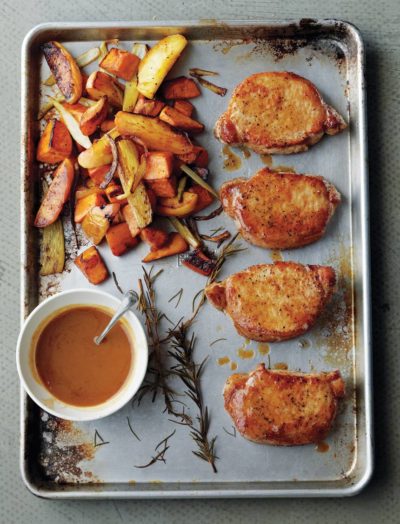
(Makes 4 servings)
Vegetables and apples:
- 1 pound red-skinned sweet potatoes (yams), peeled and cut lengthwise in half, then cut crosswise into 2-inch pieces
- 2 Pink Lady or Fuji apples, cored and cut lengthwise into eighths
- 1 large fennel bulb, trimmed and cut lengthwise into eighths
- 2 sprigs fresh rosemary, cut into 1-inch pieces
- 2 tablespoons olive oil
Pork chops:
- 4 boneless pork loin chops (each about 7 ounces and 1 inch thick)
- 2 tablespoons olive oil
- 1 cup apple cider or apple juice
- 1 tablespoon Dijon mustard
- 2 tablespoons unsalted butter, cut into two pieces
Remove pork from refrigerator and let stand at room temperature while oven preheats. Preheat oven to 450°F. Place large rimmed baking sheet in oven and heat until very hot.
Vegetables and apples: In large bowl, toss sweet potatoes, apples, fennel, and rosemary with oil to coat. Season with salt and pepper to taste. Carefully remove baking sheet from oven and spread vegetables and apples on it. Roast, turning ingredients over halfway through, for 15 minutes or until potatoes are nicely browned and tender.
Meanwhile, cook pork: Season pork with salt and pepper. Heat large heavy skillet over medium-high heat. Add oil and then add chops to skillet and cook for 5 minutes per side, or until golden brown and barely pink when pierced in center. Transfer to platter (reserving oil in skillet) and let stand for 5 minutes. Pour off all but 1 teaspoon oil from skillet, leaving brown bits in pan. Return pan to medium-low heat, add apple cider, and bring to a simmer, scraping up brown bits. Whisk in mustard and simmer for about 2 minutes to reduce liquid slightly.
Remove from heat and whisk in butter to lightly thicken sauce. Season to taste with salt and pepper. Divide sweet potato mixture among four dinner plates. Place a pork chop alongside vegetables on each plate. Drizzle with pan sauce and serve.
Per serving
- Calories: 640
- Total Fat: 30 g
- Saturated Fat: 9 g
- Sodium: 243 mg
- Carbohydrate: 56 g
- Fiber: 8 g
- Protein: 34 g
- Diabetic Exchanges: 1.5 starch, 5 very lean meat, ¼ vegetable, 2 fruit, 5 fat
Frisée and Carrot Salad with Ale Vinaigrette
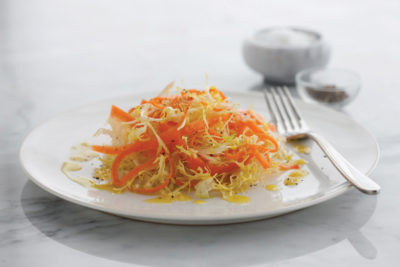
(Makes 6 servings)
- 3 tablespoons finely chopped shallots
- 3 tablespoons sour rye ale or apple cider vinegar
- 3 tablespoons white wine vinegar
- 2 teaspoons Dijon mustard
- 1/3 cup olive oil
- 2 carrots, peeled
- 3 heads frisée lettuce, white parts only (about 6 cups)
In large bowl, whisk shallots, ale, vinegar, and mustard to blend. Gradually whisk in oil. Season to taste with salt and pepper. Using vegetable peeler, peel long thin strips down length of carrots. Toss carrot strips with frisée in large bowl with enough vinaigrette to coat. Season salad to taste with salt and pepper. Divide salad among plates and serve.
Per serving
- Calories: 140
- Total Fat: 12 g
- Saturated Fat: 2 g
- Sodium: 102 mg
- Carbohydrate: 7 g
- Fiber: 3 g
- Protein: 1 g
- Diabetic Exchanges: 1.25 vegetable, 2.5 fat
This article is from the November/December 2018 issue of The Saturday Evening Post. Subscribe to the magazine for more art, inspiring stories, fiction, humor, and features from our archives.
Excerpted from What’s for Dinner? by Curtis Stone. Copyright ©2013 by Curtis Stone. Excerpted by permission of Ballantine Books, a division of Random House LLC. All rights reserved. No part of this excerpt may be reproduced or reprinted without permission in writing from the publisher.
How to Cook a Muskrat and Other Wild Dishes from 1938
Squirrel potpie? Old news according to 1938 Country Gentleman author Jim Emmett, who was on the hunt for more unusual home-cooked fare. Stuffed raccoon, parboiled porcupine, and opossum roasting over an open fire were just a few of his tasty finds. Plus, a tip for foraged edibles: Fried or drizzled, wild greens go down best with butter.
A note to the 21st-century chef: Take these dishes with a grain of salt. Food safety has changed some in the 80 years since these recipes were published. To know what’s safe to eat — and, more importantly, what isn’t — in your area, seek out local wildlife and foraging experts.
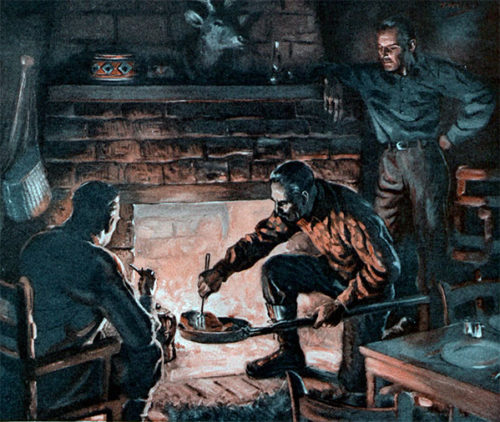
Savory Dishes from the Wild
Originally published in The Country Gentleman, March 1938
Your ancestors, or mine, may not have endured Plymouth winters, trekked Midwest plains, or even been born in this country; still, there is a good bit of the pioneer in the make-up of most Americans. A joint of venison sent to the house is eagerly enthused over, we cook precious wild ducks and upland game birds with fear in our hearts that they may be spoiled in the oven, and even prepare potpies of squirrel or rabbit more carefully than we do expensive cuts of meat.
The eating of only certain wild animals is a habit passed down from days not so far back when a farmer stepped outside his door to shoot a deer nibbling apples from the tree he cared for so carefully. Naturally, with game so plentiful nothing but the best graced his table. Fat bear and young deer not only butchered quickly but yielded a large supply of good meat at the expense of a single charge of expensive powder and precious ball. Canvasbacks and mallards were preferred when the waters of every inland pond blackened at dusk with southbound birds, and trout from the pasture brook which appeared on the breakfast table then would be entered in fish contests now.
This preference for certain wild game seems also to be a matter of location. For instance, in the North, muskrat haunches are considered a delicacy by most French-Canadian families, and in the South, opossum is enthused over on the plantation owner’s table. Frog legs are preferred to chicken drumsticks in the Adirondacks, while on many a Tidewater-Maryland farm eels are a greater favorite than the oysters, crabs, and fish lying off the wharf for the taking.
How to Pluck a Possum
The possum is more than an animal in the South; he is a distinctly American institution, and there the term opossum is considered an affectation. Many Northerners think of the possum as being eaten only by the plantation help. But those fortunate enough to sample the famed hospitality of the South, as it flourishes in rural regions, find that possum and sweet potatoes is also big-house fare. The chief difference is that the white folk bake theirs in an oven, while rural African Americans so often cook on the hearth with an open fire, suspending the possum on a wet string before a high bed of hickory coals. The twisting and untwisting string rotates the meat which is basted with a sauce of red pepper, salt, and vinegar. After having eaten possum cooked both ways, I prefer the open-fire method.
There are two golden rules to possum cooking: First, he is good only in freezing weather; secondly, do not serve without sweet potatoes. Preparation is not difficult, but like all wild things must fit the particular animal. Stick the possum and hang overnight to bleed. Next morning fill a tub with hot water, not quite scalding, and drop the possum in, holding tight to his tail for a short time so the hair will strip. It is then an easy matter to lay him on a plank and pull out all the hairs somewhat as one would pluck a chicken. After drawing, he should be hung up to freeze for two or three nights.
As a preliminary to cooking, place him in a five-gallon kettle of cold water into which has been thrown a couple of red-pepper pods, if you have them, otherwise a quantity of ground pepper. Remove after an hour of parboiling in this pepper water, throw water out, and refill kettle with fresh water, in which he should be boiled another hour.
While all this is going on, the sweet potatoes should be sliced and steamed. Take the possum out of the water, place in a large covered baking pan, sprinkle with black pepper, salt, and sage, and pack the sweet potatoes lovingly about him. Pour a pint of water in the pan, put the cover on, and bake slowly until brown and crisp. Serve hot, with plenty of brown gravy.
Haunch of Muskrat with Watercress
Muskrat haunches, usually with watercress, grace the French-Canadian farmer’s table often enough to guarantee their value as a worthwhile game dish.
Muskrats must be skinned carefully in order not to rupture the musk or gall sacks; those offered for sale on city markets are a trapper’s byproduct; often indifferent skinning spoils them for cooking. French-Canadians use only the hind legs or saddle, four animals for two servings. After a careful washing, they are placed in a pot with some water, a little julienne or fresh vegetables, some pepper and salt, and possibly a few slices of bacon or pork. After simmering slowly until half done, they are removed to a covered baking pan, the water from the pot is put in with them and baking continued with frequent basting until done.
In Maryland and Virginia, the muskrat is known as marsh rabbit and valued highly as a game dish. Cooks there use the entire animal, soaking it in water a day and night before cooking. Then follows 15 minutes’ parboiling, after which the animal is cut up and the water changed. An onion is added, with red pepper and salt to taste, and a small quantity of fat meat. Just enough water is used to keep from burning, thickening added to make gravy, and cooking continued until very tender.
Trade Thanksgiving Turkey for Roasted and Stuffed Raccoon
Coon is excellent eating if caught in cold weather. In skinning, be careful to remove the kernels or scent glands, not only under each front leg but also on either side of the spine in the small of the back. All fat should be stripped off. Wash in cold water, then parboil in one or two waters; the latter if age warrants. Roasting should continue to a delicate brown. Serve fried sweet potatoes with the meat. The coon, with its reputation of washing even its vegetable diet before eating, is one of our cleanest animals; he will not fail you as a cold-weather game dish if you observe the skinning precaution.
Parboiled Porcupine
In the North Woods the porcupine is a lost hunter’s stand-by, his emergency food supply. But unlike most emergency rations this inoffensive little animal is excellent eating, especially if young, when his flesh is as juicy and as fine flavored as spring lamb. The secret of skinning is to commence at the belly, which is free of quills; start the skin there and it pulls off as easily as that of a rabbit. Parboil for 30 minutes, after which roast to a rich brown or quarter for frying or stewing.

Fowl Cooking
The lower grades of ducks are acceptable eating if correctly prepared for cooking. All waterfowl, even the better ducks, have two large oil glands in their tail, put there by Nature to dress the bird’s feathers; these should always be removed before cooking.
The breasts of coot, rail, and young bittern are always worth serving. Cut slits in the removed breasts and in these stick slices of fat salt pork, then cook in a dripping pan in a hot oven. The rank taste of even fish ducks can be neutralized, unless very strong, by baking an onion inside and using plenty of pepper inside and out.
The meat fibers of all game birds and animals are fine grained, containing very little fat, even though the muscles themselves may be encased in it. For this reason most game recipes mention larding. This consists of laying strips of fat pork or bacon not only on top of the meat, but inserting them in slits cut in the flesh itself to prevent dryness. As a rule, dark-meated game should be cooked rare, so red juices, not blood, flow in carving. White-meated game should be thoroughly cooked. Animals and birds, tough or old, should be parboiled first; such meats are better stewed.
The Way with Turtles
Aquatic turtles are good eating at any time, old guides claiming their flesh has medicinal value. The common snapper is excellent, and preparing is not difficult. Aside from any humanitarian feeling, I do not like the method of dropping the live turtle into a tub of scalding hot water; I prefer to get that wicked head off as quickly as possible. One must carry the brute by its stocky tail well away from flapping trousers. Another man with an ax in one hand and a stick in the other extends the stick atop a convenient log. Hold the turtle near and snap go its jaws over the stick with a grip which never fails to make one realize what it would do to a foot or hand. With its neck extended, down comes the ax. One need have no qualms of pity when dealing with this enemy to wildlife.
After letting the turtle bleed, drop in scalding water, when the outside of the shell will drop right off and the skin can be easily removed. Then cut the supports of the flat undershell and remove it entirely, so the turtle can be easily cleaned. To save cutting the meat out, boil in its cleaned shell a short time, when the meat will drop off. Cut up, boil slowly three hours with chopped onion, or stew with diced salt pork and vegetables.
Freshwater Finds: Catfish, Carp, Eels, and Frogs
Proper preparation makes even our so-called coarse fish good eating. To skin bullheads or catfish, cut off the ends of sharp spines, split the skin behind and around the head, and from this point along back to the tail, cutting around back fin. Then peel two corners of the skin well down, cut backbone and hold skin in one hand while the other pulls the body free.
Carp should be carefully skinned rather than scalded. There is a layer of fat or mud between two skins and only with this removed will the fish be found good eating. Many people condemn catfish and carp as being soft fleshed; which they are if taken from too warm water. But every fish is better caught out of cold water.
Eels can be easily skinned by nailing through the tail at a convenient height. Cut the skin around the body, just forward of the tail, work edges loose, then pull down to strip off the entire skin. To broil, clean well with salt to remove slime, slit down back and take out bone, then cut in 2-inch pieces. Rub these with egg, roll in cracker crumbs or corn meal, season with salt and pepper and broil to a nice brown. To stew, cut in pieces after removing the bone, cover with water in a stewpan, and add a teaspoon of vinegar. Cover the pan and boil half an hour, then remove, pour off water and drain, add fresh water and vinegar as before and stew until tender. Finally drain again, add cream for a stew, season with salt and pepper only, and boil a few minutes to serve hot.
Smothered catfish is beloved [in the South], utilize this ugly but sweet-fleshed fish to advantage. Place a large skinned catfish in the baking pan and slice onions to put on top along with strips of bacon. Sift flour lightly over all, salt and pepper, and place in a heated oven 15 minutes.
Frog’s legs are a delicacy from the first spring days until freeze-up time. The northwoods hunting-camp cook soaks the hind legs an hour in cold water, to which vinegar has been added, as a preliminary to cooking. He then drains, wipes dry, and places them in a skillet of bubbling hot cooking oil. Some Southern tidewater shooting-camp cooks use the entire frog, other than the head; others grill the legs only. A preparation is made of three tablespoons of melted butter, half a teaspoon of salt, and a pinch of pepper. The body or the legs are dipped in this, rolled in crumbs and broiled three minutes each side.
Foraging Plants from Field and Woods
Not to be outdone, our early spring pastures and fields offer many edible greens free for the gathering. Dandelion greens, with a piece of bacon, are still regarded by many as a sure sign of spring. Milkweed shoots, wild mustard, dandelions, dock, and sorrel should be dried immediately after washing, then boiled with salt pork, bacon, or other meat. If on the old side, parboil first in water to which a little soda has been added, then drain before boiling again in plain salted water.
Perhaps you have cooked these wild things and not been satisfied with the results. Try chopping the boiled greens fine, then putting in a hot frying pan with butter, pepper, and salt, and stirring until thoroughly heated.
The tender stems of young brake or bracken [fern], cooked same as asparagus, are equally as good as that much-sought-after vegetable. The plants should not be over 4 inches high when they will show but a few tufts of leaves at the top; if much older they are unwholesome. Wash the stalks, scrape, and lay in cold water for an hour. Then tie loosely in bundles and put in a kettle of boiling water to boil three quarters of an hour, when they should be tender. Drained, laid on buttered toast, dusted with pepper and salt, and covered with melted butter they are as good as asparagus, some claim even better.
Wilted dandelion greens call for a peck of fresh tops and half a dozen strips of bacon. Fry the bacon until crisp, then crack into small pieces and pour with drippings over the washed leaves.
Botanists tell us over a hundred edible plants grow wild in our fields and woods. While we may find it easier to raise cultivated vegetables than to gather wild things, it is good to know we live where Nature offers this wholesome fare.
News of the Week: Christmas Wars, Computer Concerns, and the Case of the Confusing Yam

Starbucks and the War on Christmas
Ah, the Christmas season. That time of year when bells jingle, choirs sing, snow falls, and people argue about paper cups.
It seems that the War on Christmas comes earlier and earlier every year. This year’s battle centers on Starbucks. This year the coffee shop chain decided to go with a plain red cup with their green and white logo, instead of something featuring Santa or reindeer or snowflakes, and some people are rather upset by that decision.
Here’s the thing: As E! Online illustrates, the company’s cups are always rather minimalist, and if they do have something on them it’s usually a drawing of snowflakes or a reindeer or ornaments and trees. And is there even any religious aspect to snowflakes and reindeer and candy canes we’re missing by having a bare cup this year?
To be clear, Starbucks says there is no directive for employees not to say merry Christmas to their customers, and they do sell coffee labeled Christmas Blend, a Merry Christmas gift card, an Advent calendar, and many other festive things. While I do think that there have been examples of companies and towns being overly politically correct during the Christmas season in the past, this isn’t one of those times. As even The National Review says, viewing plain coffee cups as an attack on religion is embarrassing.
Of course, presidential contender Donald Trump has weighed in on the controversy. While Trump said, “Seriously, I don’t care,” he also hinted he might end the Starbucks lease at Trump Tower, adding “maybe we should boycott Starbucks. … If I become president, we’re all going to be saying merry Christmas again — that I can tell you.”
And millions of people around the country are waiting to see just how he’s going to enforce that.

The End of the Personal Computer?
In an interview with The Telegraph Apple CEO Tim Cook asks the question, “I think if you’re looking at a PC, why would you buy a PC anymore? No really, why would you buy one?” And to answer that I would say, “Because I like them, that’s why!”
If he wanted me to expand on my answer, I’d say it’s because a laptop (or desktop) is the natural tech to use for producing content like writing. I haven’t used tablets or smartphones that much, but I can’t imagine working on them for an extended period of time. Movies? Games? Surfing the Web? Sure. But for real work I’ll go the traditional route (and there’s no way I’m going to start doing everything on a watch).
It’s a little disconcerting to hear the CEO of the company that makes the MacBook laptops say that the personal computer is going away because a MacBook is what I’m typing on right now. But I’m going to predict that we’re still going to have desktops and laptops for many years to come, so don’t worry about it.

Ranking the Bonds
Whenever a new James Bond movie opens, people love to rank all the movies and the people who have played 007. With SPECTRE in theaters now — and don’t listen to the critics, it’s a good flick — I thought I’d rank the Bonds.
The way it usually works is that you like the Bond you grew up with. I didn’t see any of the Sean Connery movies in the theaters — I saw all the Roger Moore ones there though — but I watched Connery’s Bond countless times on TV and he will always be number one to me.
- Sean Connery
- Daniel Craig
- Timothy Dalton
- Pierce Brosnan
- George Lazenby
- Roger Moore
- Barry Nelson (played Bond in a 1954 episode of the anthology series Climax!)
- Everyone who played Bond in the awful 1967 version of Casino Royale
Who’s your favorite Bond?
The Blackout of 1965
Where were you when the lights went out in the Northeast in 1965? I was around 5 months old so I was probably in my mother’s arms or, knowing me, crying because the TV just went out. The blackout, caused by human error, affected many states, including New York, Massachusetts, Connecticut, New Hampshire, Vermont, New Jersey, Pennsylvania, and even Ontario, Canada. While not everyone in those places lost power, the outage did hit 30 million people, and they didn’t have power anywhere from just a few hours to over 13 hours. Imagine this happening today, and people couldn’t post on Facebook for 13 hours. Oh the humanity!
This week marked the 50th anniversary of the event. Here’s NBC’s breaking news coverage:
The Return of MST3K
In the not-too-distant future, probably 2016 AD, we’re going to see the return of the original Mystery Science Theater 3000. After 15 years and the straightening out of some legal issues, creator and original host of the make-fun-of-movies show Joel Hodgson is bringing it back.
- This time there will be a different host and some new cast members, along with some of the original cast and writers we loved way back when. Hopefully that will include former cast members Michael J. Nelson, Kevin Murphy, and Bill Corbett, who are currently doing the fantastic RiffTrax.
They’ve set up a Kickstarter and it has already reached $1 million, and there’s still almost a month to go in the campaign. The gang hopes to reach at least $2 million, so they can do three episodes on DVD/online. If they reach $3.3 million, they’ll do 6. $4.4 million will get us 9 episodes, and $5.5 million will mean a full 12-episode season.
Fa la la!
![IBM WatsonBy Clockready (Own work) [CC BY-SA 3.0 (http://creativecommons.org/licenses/by-sa/3.0) or GFDL (http://www.gnu.org/copyleft/fdl.html)], via Wikimedia Commons](https://www.saturdayeveningpost.com/wp-content/uploads/satevepost/20151113-ibm-watson.jpg)
By Clockready (Own work) [CC BY-SA 3.0 (http://creativecommons.org/licenses/by-sa/3.0) or GFDL (http://www.gnu.org/copyleft/fdl.html)], via Wikimedia Commons
Watson, The IBM Chef
Sure, IBM’s Watson computer can beat Jeopardy! champions Ken Jennings and Brad Rutter, but can it make beef stroganoff?
I don’t really know. I would love to explore the IBM Chef Watson site more thoroughly, but you have to register with either a Facebook or IBM account. I have neither so what I can see on the site is rather limited. Apparently you can use the site — a joint effort between IBM and Bon Appetit — to create recipes and share them with your friends.
The recipes I’ve seen on the site include a Tomato Tart, Party Bourbon Punch, Salmon Tacos, and a Russian Celery Parsley Bread Lemon Juice Sandwich (yes), created by engineer and chef Florian Pinel for his TED Talk about food waste.
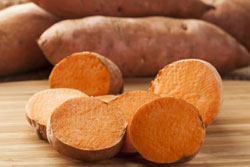
Sweet Potatoes Are Yams
I wonder if Watson knows the difference between sweet potatoes and yams? It will soon be Thanksgiving so I thought I’d investigate.
According to The Kitchn, there really isn’t any difference. The yams we eat here in North America are sweet potatoes, even if they’re labeled “yams.” A real yam is native to Africa and Asia and you’re probably not going to find one, unless you go to a specialty supermarket. And to confuse things more, there are two types of sweet potatoes, firm and soft. The yams you find at the supermarket are the soft, sweet potatoes and are labeled yams because they kinda look like real yams. Got that? Good. Maybe you can explain it to me.
I’ve been eating canned yams, the ones in sweet syrup, for many years, while at the same time refusing to eat the sweet potatoes at the Thanksgiving table. I guess it’s time to revisit sweet potatoes, as long as they’re covered in enough stuff like cinnamon and marshmallows to mask the taste. When you reach a certain age, it’s hard to change your eating habits. I yam what I yam.
Upcoming Events and Anniversaries
Suez Canal opens (November 17, 1869)
The 101-mile waterway connects the Mediterranean Sea to the Red Sea.
President Nixon’s “I am not a crook” press conference (November 17, 1973)
Nixon made the comments while meeting with 400 Associated Press editors in Orlando, Florida.
The “Heidi Game” (November 18, 1968)
The New York Jets vs. Oakland Raiders game had a really exciting ending. Too bad NBC interrupted it with a showing of the movie Heidi.
President Lincoln delivers Gettysburg Address (November 19, 1863)
Here’s the full transcript of Lincoln’s speech in Gettysburg, Pennsylvania.
Nuremberg trials begin (November 20, 1945)
The post-World War II military tribunals prosecuted military and political leaders of Nazi Germany.
Terry Walters’ Sweet Potato, Corn, and Kale Chowder
When I prepare dinner, I try to make sure there’s something for everyone. This chowder accomplishes that in one pot and is a colorful variation on an old favorite. It cooks up quickly and provides a balanced meal, rich in nutrients, all in one satisfying bowl.
Sweet Potato, Corn, and Kale Chowder
(Makes 6 servings)
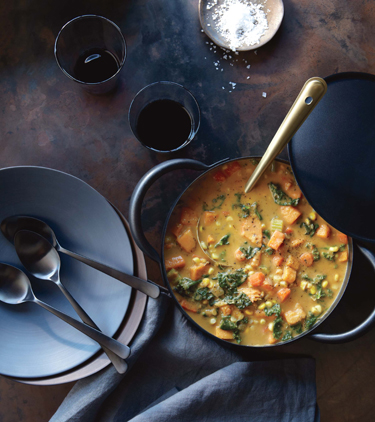
Ingredients
- 1 tablespoon grapeseed oil
- 1 small onion, diced
- 3 stalks celery, diced
- 3 carrots, diced
- 3 medium sweet potatoes, peeled and diced
- 3 cups corn, fresh or frozen
- 2 teaspoons dried thyme
- 2 cups vegetable stock
- 2 cups rice milk, plus more if needed
- 2 tablespoons cashew butter, dissolved in ¼ cup hot water
- 1 bunch kale, chopped into small pieces
- Water or stock as needed
- Sea salt and freshly ground black pepper
Directions
- In large pot over medium heat, sauté onion in oil until soft (about 3 minutes).
- Add celery, carrots, sweet potatoes, corn, thyme, and stock and simmer 5 minutes.
- Add enough rice milk to cover vegetables.
- Bring to boil, reduce heat and simmer until vegetables are soft (about 20 minutes).
- Remove from heat, and add dissolved cashew butter. Partially puree using handheld blender.
- Add kale, return to heat, thin with water or stock to achieve desired consistency, and cook until kale is tender.
- Season to taste with salt and pepper, and serve.
Nutrition Facts
Calories: 245
Total fat: 7.8g
Carbohydrate: 44g
Fiber:56g
Protein: 5.6g
Sodium: 350mg
Reprinted with permission from Clean Food, Revised Edition © 2010 by Terry Walters, Sterling Epicure, an imprint of Sterling Publishing Co. Inc., Photography by Gentl & Hyers.
Sweet Potatoes for All
Let’s give a big shout-out to the sensational sweet potato! This versatile veggie is widely available, inexpensive, and delicious. But here’s even more to love: sweet potatoes also deliver a big dose of healthy eating for just pennies per serving.
The nutritional numbers speak for themselves: one medium sweet potato provides 40 percent of the recommended daily allowance of vitamin C to fight off colds and flu viruses and vitamin D for bones and a healthy immune system. Plus, when eaten with the skin, it has more fiber than oatmeal. The colorful and creamy food is also low in fat and a good source of protein and calcium.
- So, whether sweet potatoes are a perennial favorite or making their debut in your holiday spread, try out these ideas:
- Bake or microwave, then top with butter pat and cinnamon. Try chili powder for a Southwestern twist.
- Grill, slice, and serve over greens.
- Purchase a bag of pre-chopped sweet potato from the produce section of your grocery store. Enjoy as a snack, or in salads and soups.
- Mash baked sweet potatoes with shallots, curry powder, cinnamon, and ground red pepper to taste.
One Medium Sweet Potato
Calories: 120
Percent Daily Value: Fat 0%
Cholesterol: 0%
Protein: 4%
Total Carbs: 10%
Dietary Fiber:10%
Sodium: 0%
Vitamin: A 500%
Calcium: 4%
Vitamin C: 45%
Vitamin D: 60%
Talking Turkey
Humorist Erma Bombeck eagerly anticipated Thanksgiving Day.
“What we’re really talking about is a wonderful day set aside on the fourth Thursday of November when no one diets,” wrote Bombeck. “I mean, why else would they call it Thanksgiving?”
Humor aside, no one has to sacrifice great taste for good health. Dubbed one of the world’s healthiest “super foods,” lean protein-rich turkey is the undisputed star of the annual feast.
This year, introduce your family to a new tradition by serving Turkey Breast Provençal With Vegetables—a savory, easy-to-prepare entrée—along with Garlicky Mashed Sweet Potatoes, a fresh twist on a family favorite.
Still crave more turkey? Everyone will welcome a bountiful bowl of Turkey Vegetable Soup, a comforting, wholesome solution that the entire family will enjoy.
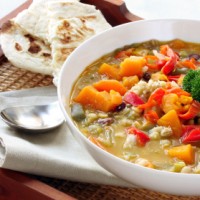
Turkey Vegetable Soup
(Makes 4 servings)
- 2 1⁄2 pounds turkey breast
- 5 cups cold water
- 2 onions, quartered
- 1 carrot, cut in chunks
- 1 bay leaf
- 5 black peppercorns
- 2 cubes low-sodium turkey broth or chicken bouillon
- 1 can corn, or one ear corn, cut into 1⁄2″ slices
- 1 carrot, peeled and cut into 1⁄2″ slices
- 1 stalk celery, cut into 1⁄2″ slices
- 1 medium zucchini, cut into 1⁄2″- 3⁄4″ slices
- 4 medium tomatoes, peeled and cut into quarters
- 1 cup sugar-snap peas or green beans
- 1 medium leek, well rinsed and thinly sliced
- 1⁄2 cup lima beans
- 1 cup broccoli flowerettes
- 3 tablespoons pearl barley
- 3 tablespoons fresh parsley, chopped; or 1 tablespoon dry
- 1 1⁄2 teaspoons fresh oregano, chopped; or 1⁄2 teaspoon dry
- 1 clove garlic, mashed with 1⁄4 teaspoon salt (optional)
- 3⁄4 teaspoon freshly ground black pepper
In 5-quart saucepan, combine first seven ingredients. Bring to boil over high heat. Skim off any foam. Reduce heat, cover and simmer mixture 1-11⁄4 hours. Remove turkey from cooking liquid and allow to cool. Remove poultry from bones, discarding skin and bones. Cube poultry, cover and chill.
Strain broth. Discard seasoning, vegetables and spices. Skim off any remaining fat. Return broth to saucepan.
Add remaining vegetables, barley and seasonings. Over high heat, bring mixture to a boil. Cover and immediately reduce heat to a simmer. Cook 20 minutes or until all vegetables are tender. Add reserved turkey and gently cook 5-10 minutes. Adjust seasoning to taste.
Turkey Breast Provençal with Vegetables
(Makes 12 servings)
- 1 cup turkey broth, or reduced-sodium chicken broth
- 1⁄4 cup dry white wine
- 1⁄4 cup freshly squeezed lemon juice
- 1 head garlic, cloves separated, unpeeled
- 1 bag (10 oz.) frozen whole petite onions
- 2 teaspoons dried rosemary, crushed
- 1 teaspoon dried thyme leaves
- 1⁄2 teaspoon kosher salt
- 1⁄4 teaspoon fennel seeds, crushed
- 1⁄4 teaspoon black pepper
- 6 plum tomatoes, quartered
- 1 box (9 oz.) frozen or fresh artichoke hearts, slightly thawed
- 10 ounces frozen or fresh asparagus spears, slightly thawed
- 1 can (31⁄4 oz.) pitted black olives, drained
- Olive oil, salt and black pepper as needed
- 1 bone-in turkey breast (41⁄2 lbs.), fresh or thawed if frozen.
In 9″x13″ baking pan combine broth, wine, lemon juice, garlic, onions, rosemary, thyme, salt, fennel seeds, and pepper. Cover pan with foil. Heat 20 minutes in preheated 325° F oven. Remove pan from oven.
Add tomatoes, artichoke hearts, asparagus and olives in pile in center of pan. Rub turkey breast with olive oil and sprinkle with salt and pepper. Place turkey breast—breast side up—on top of vegetables. Float foil over top of turkey and roast 1 hour. Remove foil and roast additional hour or until food thermometer inserted in thickest part of breast registers 170° F. Baste turkey and vegetables frequently with pan juices. Remove turkey and vegetables to serving platter. Reserve 6 cloves garlic and pan juices. Remove skin from reserved garlic. Combine garlic with pan juices in food processor bowl, fitted with metal blade. Process 30-60 seconds until mixture is smooth. Reheat sauce to piping hot.
To serve, pass sauce to pour over turkey and vegetables.
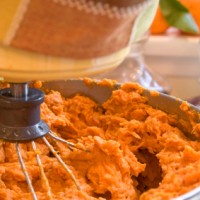
Garlicky Mashed Sweet Potatoes
(Makes 4 servings)
- 2 sweet potatoes (about 8 oz. each)
- 2 sprigs fresh rosemary
- 1 sprig fresh thyme
- 3 whole garlic cloves, peeled
- 1⁄2 teaspoon salt
- 1⁄2 teaspoon pepper
- 3 cups chicken broth, plus extra if needed
- 3 tablespoons butter
- 1⁄4 cup low-fat sour cream
- 1⁄4-1⁄2 cup low-fat milk
Peel and cut each sweet potato into eight pieces. Place in medium saucepan with herbs, garlic, salt, pepper and broth. Add additional broth, if needed, to cover sweet potatoes. Bring to boil, reduce heat and simmer 15-18 minutes or until tender when pierced with fork. Drain sweet potatoes. Discard rosemary and thyme. Transfer sweet potatoes and garlic to medium bowl and lightly mash with fork. Add butter, sour cream and milk. Using hand mixer on low speed, mix until well blended and slightly chunky. Adjust seasonings to taste. Serve warm.
More Great Turkey Recipes!
Crock Pot Turkey Meatloaf
Turkey Pumpkin Chili
Turkey Potpie